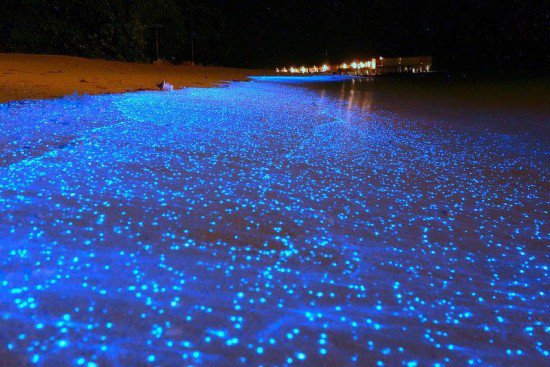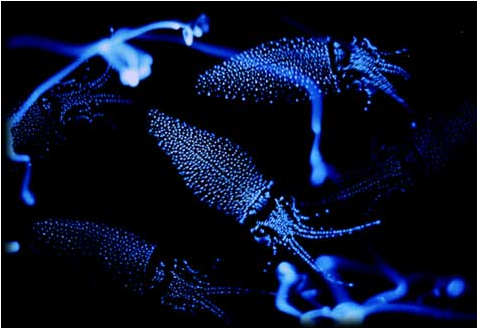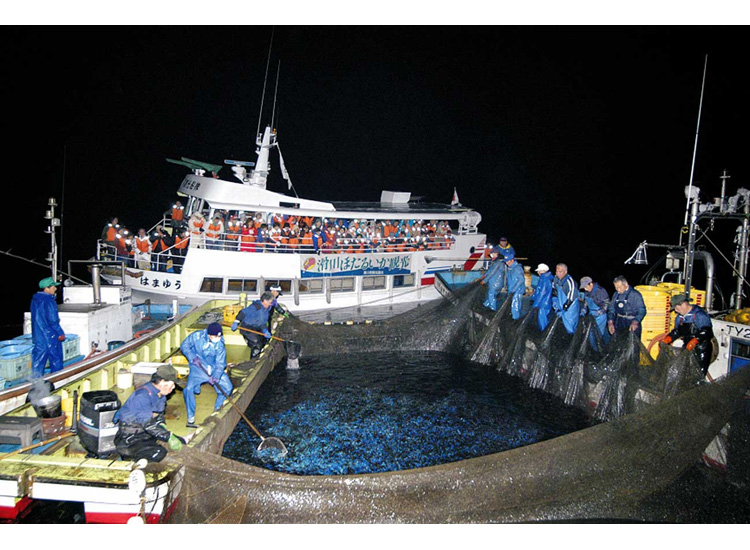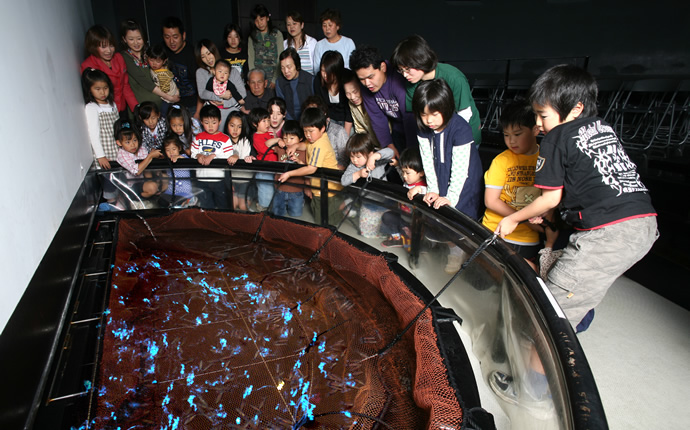
photo by odditycentral
Do you know firefly squids? Yes, those little squids that often turn up on the dinner table in many types of dish during spring season. Other than being used as a great food ingredient, firefly squids can be seen in abundance on the shoreline of Toyama bay during the highest season of its fishery, between March and May. This phenomenon is called “Hotaruika no minage”, illuminating the shores of Toyama bay with countless number of squids glowing in neon blue. It was being enjoyed by only local residents as a seasonal view, but it is now attracting huge number of tourists from other cities in Japan or even from overseas since it got a lot of visibility. Well, let’s see when or where we can see “hotaruika no minage”, the fantastic view of shoreline lit up by thousands of neon blues.
About firefly squids

photo by wikipedia
The firefly squids have rather small bodies and measure about 7cm. they emits beautiful blue lights from numerous photophore organs equipped on its tentacles or body surface. It is considered that they produce lights to intimidate possible predators they encounter, or disguise themselves from predators below the surface by camouflaging their body into the lights from above. There are many types of glowing squids all over the world. As for the areas around Japan, the entire Japan Sea and some part of the Pacific Ocean is main habitat of them. Especially the coast of Toyama Bay from Toyama to Uozu is the best known for the production of firefly squids. The city become the busiest with the squid fishing during the breeding season of the firefly squids every spring. Those squids are used as food ingredients for Tsukudani, squid fries or sashimi in modern days. But it used to be uitlized as fertilizer of pine trees as it quickly goes rotten.
What is “hotaruika no minage”?
Toyama Bay, where is best known for the firefly squid production, become busy with local residents and tourists who have gathered to see “hotaruika no minage”. “Minage” normally means “drowning oneself” and you might be wondering if squids would possibly kill themselves. It is not about suicidal squids. “Hotaruika no Minage” is a very unique phenomenon that numerous firefly squids rush to the shore in Toyama Bay only when all the conditions are met during the breeding time, March to May every year. Firefly squids that normally live at the depth of 200 to 700 meters during the day surge to the surface once night falls. Then they gather to the shore to lay eggs during breeding season. Mobs of glowing firefly squids light up the shoreline in neon blue, making it look as if a gleaming blue belt. This fantastic illumination in the deep dark night definitely shouldn’t be missed.
This amazing scenery can be seen only at Toyama Bay in Toyama prefecture. The location is also limited to the 15km of coast line from Mizuhashi to Uozu. In addition, this is such a rare event and does not happen every night. This phenomenon can be seen only if many of conditions are fulfilled.
See this website (Japanese) for your information
Best season for the firefly squids
The firefly squids on the shore can be seen during their breeding season, March to May every year, however it does not happen all the time even within this period. As this is deeply related to breeding activities, a very important event of their lives, it occurs only if all the conditions are met just like aurora. I addition, a few factor are considered to make this phenomenon happen, but none of them have ever been confirmed as the cause of this incident. However, the local residents think the following conditions contribute to make the firefly squids rush to the shore.
- Right before or after the new moon
- High tide occurs between midnight and predawn
- The ocean is calm
- Clear day and clear sea water
- South wind from the land to the ocean
※The new moon in April and May 2016 are April 7th 20:25 and May 7th 04:30
The reason why those conditions drive the firefly squids rush to the shore has never been revealed. However, some say the firefly squids identify their own location by detecting the moon light, therefore they often get lost on the new moon and washed away to the shore.
Other Activities
Other than watching firefly squids on the shore, there are some more events and activities during March to May.
Firefly squid catching

photo by nisimoto
On the day that mobs of firefly squids are rush to the shoreline to lay eggs, people can enjoy catching the squids with a fishing net or other tools on the shoreline or fishing ports around Namerikawa, where is known for the firefly squid fishery. There is no need to obtain a fishery license to catch firefly squids. Just drop by one of local fishing shop and inquire the shop staff about the best spot and other useful information before you try firefly squid catching.
Firefly Squid Tour

photo by namerikawa-kankou
Just for one month between March and May, in the highest season of the firefly squid fishery, boat tours are run for tourists to observe firefly squid fishing by using a fixed-net. The tour boat leaves the port early in the morning 3am, but the scenery is worth watching as this can be seen only during limited time every year. Booing is required.
Firefly squid tour (Japanese)
Firefly Squid Museum

photo by hotaruikamuseum
Don’t warry if you couldn’t watch firefly squids from the shore. The Firefly Squid Museum exhibits a firefly squid light show. See how the firefly squids emit light by shaking a net in the special pool to give them little shock. Also, you can learn about their biology and the firefly squid fishing.
Firefly Squid Museum light show (Japanese)
From 19 March to late May 2016
Fees: Adult JPY800, Child JPY400
Summary
The glowing firefly squids on the shore is a very rare event that happens only a few days during a limited time every year. This is something you must see if you have a chance. Make sure to take a jacket with you in case of cool whether even though it is spring time as the incident happens from midnight to before dawn. Also, it is expected to be very busy during the firefly squid season, especially during the tie of new moon. Just pay a little attentions to public manner and enjoy watching this seasonal illumination of the nature.
